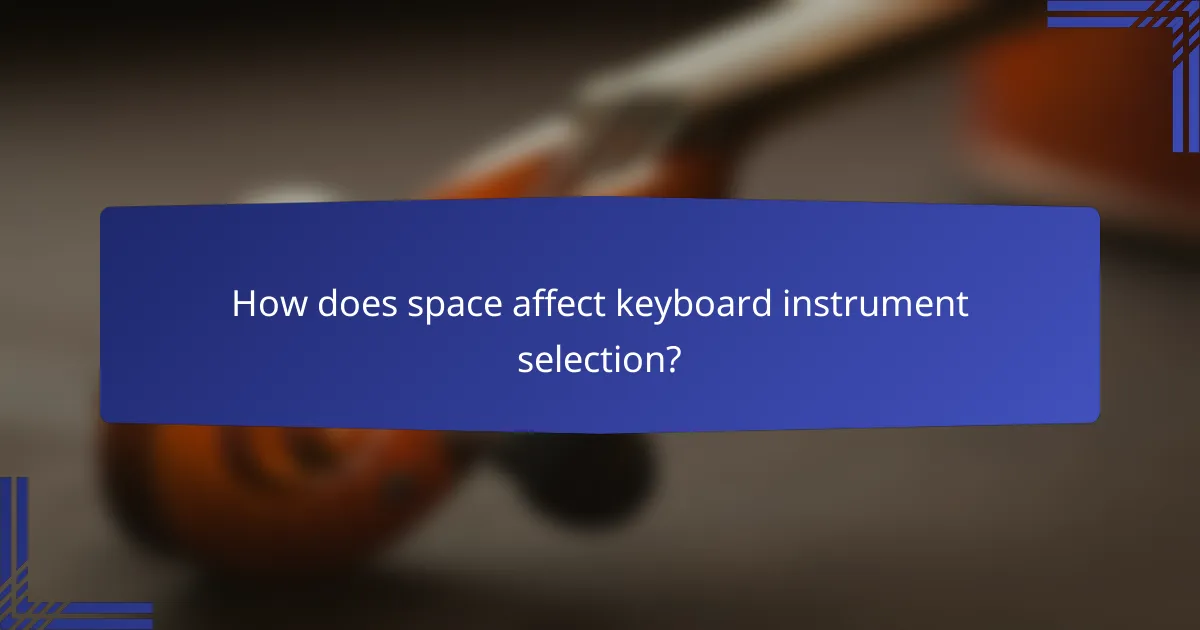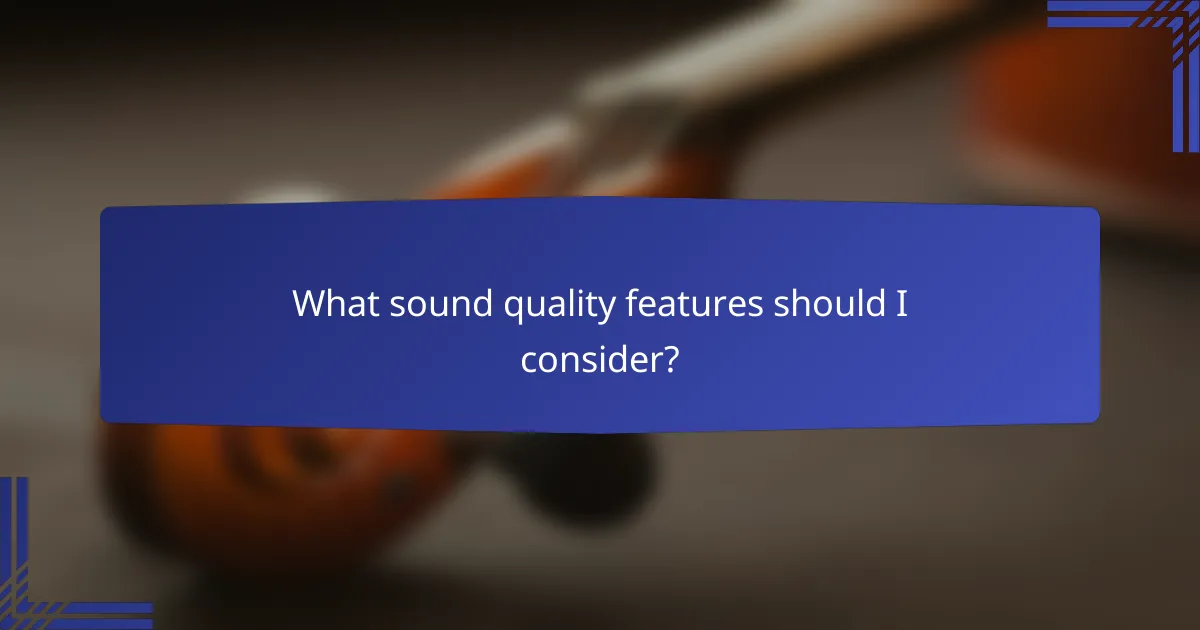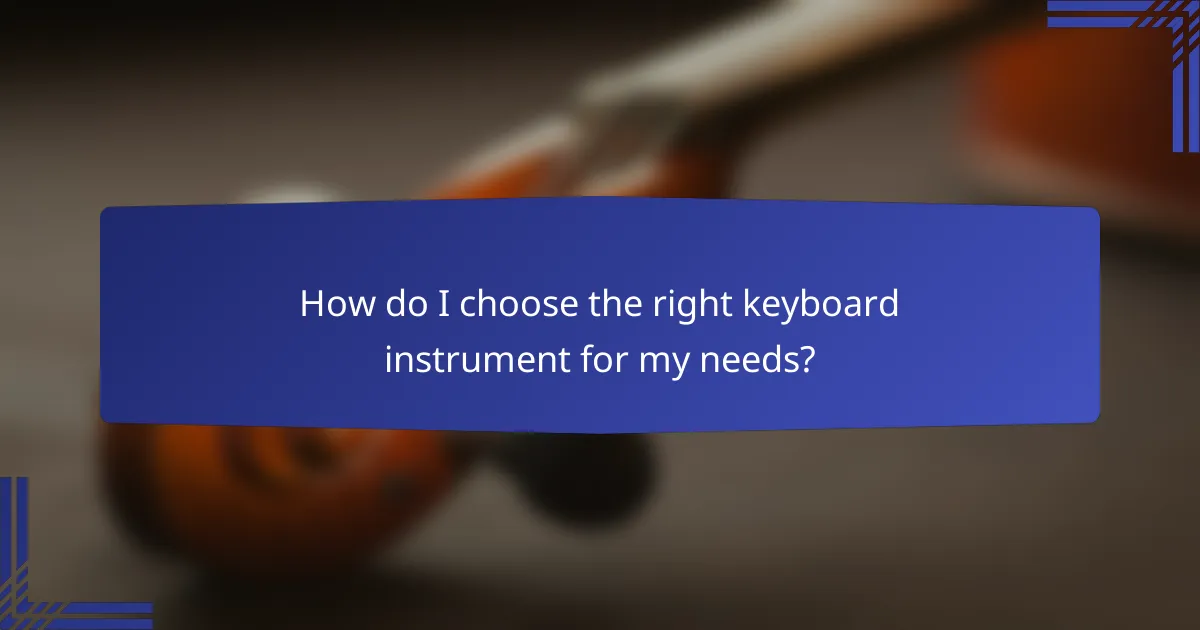Choosing the right keyboard instrument for home use involves balancing functionality, sound quality, and space considerations. Digital pianos and portable keyboards are excellent options, providing realistic sounds and features that cater to various skill levels. The dimensions of your space play a crucial role in this decision, as compact models are ideal for smaller areas, while larger rooms can support full-sized instruments that deliver superior sound quality. Key factors to assess include polyphony count, sampling technology, and speaker quality, all of which greatly impact the instrument’s performance and overall sound experience.

What are the best keyboard instruments for home use?
The best keyboard instruments for home use combine functionality, sound quality, and space efficiency. Digital pianos and portable keyboards are popular choices, offering realistic sounds and features suitable for various skill levels.
Yamaha P-125 digital piano
The Yamaha P-125 is a compact digital piano known for its authentic sound and feel, making it ideal for home practice. It features weighted keys that simulate an acoustic piano’s touch, enhancing the playing experience.
With built-in speakers and a variety of voices and rhythms, the P-125 allows for versatile music creation. Its slim design makes it easy to fit into smaller spaces, and it typically retails around $600 to $700.
Roland FP-30X portable piano
The Roland FP-30X is a highly portable digital piano that offers excellent sound quality and connectivity options. It features a responsive key action and a wide range of sounds, making it suitable for both beginners and advanced players.
This model includes Bluetooth connectivity, allowing users to connect to music apps easily. Priced around $700 to $800, it balances quality and portability, making it a great choice for home use.
Korg B2 digital piano
The Korg B2 is an affordable digital piano designed for beginners and casual players. It offers a variety of sounds and a user-friendly interface, making it easy to start playing right away.
With a compact design and a price range of approximately $500 to $600, the B2 is perfect for those with limited space. Its built-in speakers and headphone output provide flexibility for practice without disturbing others.

How does space affect keyboard instrument selection?
The size and layout of your space significantly influence the choice of keyboard instruments. Smaller areas may require more compact models, while larger rooms can accommodate full-sized options that offer enhanced sound quality and features.
Compact models for small apartments
For small apartments, compact keyboard instruments such as digital pianos or portable keyboards are ideal. These models typically range from 61 to 76 keys, making them easier to fit into tight spaces without sacrificing too much functionality.
When selecting a compact model, consider features like weighted keys for a more authentic feel and built-in speakers for convenience. Brands like Yamaha and Casio offer excellent options that balance size and sound quality.
Full-sized options for dedicated spaces
In dedicated spaces, full-sized keyboard instruments, such as acoustic pianos or 88-key digital pianos, provide a richer sound experience. These instruments often feature superior sound engines and more extensive polyphony, enhancing the overall musical performance.
When choosing a full-sized option, ensure you have adequate space for the instrument and consider additional factors like sound isolation and room acoustics. Brands like Steinway and Roland are known for their high-quality full-sized pianos that cater to serious musicians.

What sound quality features should I consider?
When evaluating sound quality features for keyboard instruments, focus on polyphony count, sampling technology, and speaker quality. These elements significantly influence the overall sound experience and performance capabilities of the instrument.
Polyphony count
Polyphony count refers to the number of notes a keyboard can produce simultaneously. A higher polyphony count, typically ranging from 32 to 256 notes, allows for more complex musical passages without note dropouts. For serious musicians, aiming for at least 64 notes is advisable to ensure a rich sound during layered playing.
Consider your playing style when assessing polyphony. If you often use sustain pedals or play intricate pieces, opt for keyboards with higher counts to avoid losing notes. Conversely, casual players may find lower counts sufficient for basic compositions.
Sampling technology
Sampling technology determines how accurately a keyboard reproduces the sound of real instruments. High-quality sampling captures the nuances of acoustic instruments, often using multi-sampling techniques to record various dynamics and articulations. Look for keyboards that utilize advanced sampling methods like velocity layering for a more authentic sound.
Additionally, pay attention to the bit depth and sample rate. A standard of 16-bit/44.1 kHz is common, but higher specifications can enhance sound fidelity. If you’re looking for realism, prioritize keyboards with superior sampling technology.
Speaker quality
Speaker quality impacts how sound is projected and perceived. Keyboards with built-in speakers should have a good wattage rating, typically between 5 to 20 watts, to ensure clear sound output. Larger speakers generally provide better bass response and overall sound richness.
When testing a keyboard, listen for clarity across different volume levels. Avoid models with tinny or distorted sound, especially at higher volumes. If possible, consider external amplification options for a more robust sound experience during performances or practice sessions.

Which brands offer the best sound quality?
Brands like Yamaha, Roland, and Korg are renowned for their exceptional sound quality in keyboard instruments. Each brand has unique features and technologies that enhance audio performance, catering to different musical styles and preferences.
Yamaha
Yamaha keyboards are celebrated for their rich, natural sound quality, often utilizing advanced sampling technology. The AWM (Advanced Wave Memory) system captures real instrument sounds, providing a realistic playing experience.
When choosing a Yamaha keyboard, consider models with the Graded Hammer Standard (GHS) action for a more authentic piano feel. Popular series like the P and CP offer excellent sound quality suitable for both beginners and professionals.
Roland
Roland is known for its innovative sound engines, such as the SuperNATURAL technology, which delivers expressive and dynamic tones. This brand often emphasizes versatility, making it a favorite among performers and composers.
For optimal sound quality, look for Roland models equipped with the V-Piano technology, which simulates the nuances of an acoustic piano. The RD and FP series are particularly well-regarded for their sound fidelity and performance capabilities.
Korg
Korg keyboards are recognized for their vibrant and diverse sound palette, often featuring cutting-edge synthesis technology. The Kronos and Nautilus series provide a wide range of sounds, from classic pianos to modern electronic tones.
When selecting a Korg keyboard, consider the user interface and sound editing capabilities, as they can significantly enhance your creative process. The affordability of entry-level models like the Kross also makes Korg a popular choice for aspiring musicians.

What are the key functionalities of modern keyboard instruments?
Modern keyboard instruments offer a variety of functionalities that enhance performance, creativity, and connectivity. Key features include touch sensitivity, diverse connectivity options, and built-in effects that allow musicians to customize their sound and interact with other devices.
Touch sensitivity
Touch sensitivity refers to the ability of a keyboard to respond to the pressure applied to its keys. This feature allows for expressive playing, where softer touches produce quieter sounds and harder presses result in louder notes. Most digital pianos and synthesizers today come with varying levels of touch sensitivity, often categorized as graded or uniform.
When choosing a keyboard, consider the touch sensitivity settings that best match your playing style. Graded touch sensitivity mimics acoustic pianos, with heavier keys in the lower register and lighter keys in the upper register, making it ideal for classical players.
Connectivity options
Modern keyboard instruments typically offer a range of connectivity options, enabling musicians to connect to computers, audio interfaces, and other devices. Common connections include USB, MIDI, and audio outputs, which facilitate recording and live performance setups.
When selecting a keyboard, check for compatibility with your existing equipment. USB connections are standard for easy plug-and-play functionality, while MIDI ports allow for more complex setups with multiple instruments and software. Ensure the keyboard supports the necessary protocols for your intended use.
Built-in effects
Built-in effects enhance the sound quality and versatility of keyboard instruments. Common effects include reverb, chorus, and delay, which can transform a basic sound into a rich, layered experience. These effects are often adjustable, allowing musicians to customize their sound to fit different musical styles.
When evaluating keyboards, consider the variety and quality of built-in effects. Some models offer extensive effect libraries, while others may have limited options. Experimenting with these effects can significantly impact your performance, so choose a keyboard that aligns with your creative goals.

How do I choose the right keyboard instrument for my needs?
Choosing the right keyboard instrument involves assessing your skill level, determining your budget, and evaluating the space you have available. Each of these factors plays a crucial role in ensuring that you select an instrument that suits your musical aspirations and practical circumstances.
Assessing skill level
Your skill level significantly influences the type of keyboard instrument you should consider. Beginners may benefit from simpler models with fewer features, while intermediate and advanced players might prefer instruments with more complex functionalities and better sound quality.
For beginners, a basic digital piano or a keyboard with built-in learning tools can be ideal. In contrast, experienced players might look for stage pianos or synthesizers that offer extensive sound libraries and advanced connectivity options.
Determining budget
Your budget is a key factor in selecting a keyboard instrument. Prices can vary widely, from entry-level keyboards costing a few hundred USD to high-end digital pianos and synthesizers that may exceed several thousand USD.
Establish a budget range before shopping. Consider not just the instrument’s price but also potential additional costs, such as accessories (stands, pedals, and cases) and maintenance. A good rule of thumb is to allocate about 20% of your budget for these extras.
Evaluating space requirements
Space requirements are crucial when choosing a keyboard instrument. Consider the dimensions of the instrument and the area where you plan to place it. Some keyboards are compact and portable, while others, like full-sized pianos, require more room.
Measure your available space and think about how often you will move the instrument. If you have limited space, a smaller keyboard or a digital piano with a slim profile may be the best option. Additionally, consider whether you need a stand or if the keyboard will be placed on a desk or table.
